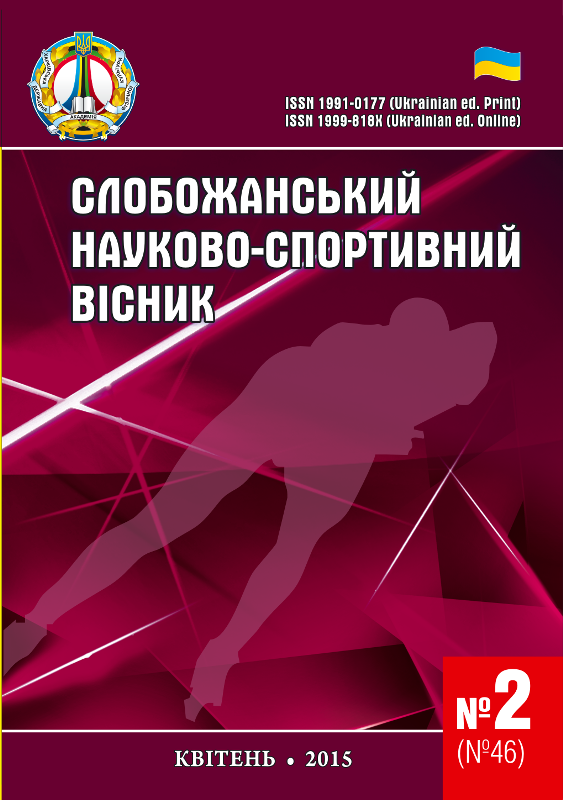Biological age as a determinating factor of individualization of physical education of children
DOI:
https://doi.org/10.15391/snsv.2015-2.042Keywords:
physical education, physical development, biological age, chronological age, types of constitutionAbstract
Purpose: to examine the existing methods of determine biological age of the children and choose the most affordable for the population. Material and Methods: theoretical analysis and generalization of literary sources. Results: the article presents a comparative analysis variety methods for determining the biological age. The qualitative component ratio of the body structure without its total volume and weight of body weight is the most effective method of determining the quality indicators of biological age. Conclusions: the main indicator of the biological age should be considered as a function of weight formation (weight) of the body that is associated in meaning with average population values.
References
Zhernovnikova Ya. Otsenka biologicheskogo vozrasta i obespecheniye nablyudayemogo v nem individualnogo razvitiya : Materiali IX mezhdunarodna nauchna konferentsiya, «Bdeshcheto vprosi ot sveta na naukata», tom. 39. Fizicheskaya kultura i sport [Evaluation of biological age and ensure it is observed in individual development : Materials IX International Conference, "Future issues of the world of science", Vol. 39. Physical Culture and Sport], Sofiya, 2013, pp. 32–39. (rus)
Raumberg. Anatomiya [Anatomy], Saint Petersburg, 1900, p. 59. (rus)
Zhofrua-Sent-Iler. Obshchaya i chastnaya istoriya anatomii teloslozheniya [General and particular history of anatomy body], Paris, 1836, 382 p. (rus)
Druz V. A., Artemyeva G. P., Buren N. V. at al. Teoreticheskiye i prikladnyye osnovy postroyeniya monitoringa fizicheskogo razvitiya, fizicheskoy podgotovlennosti i fizicheskogo sostoyaniya razlichnykh grupp naseleniya [Theoretical and practical bases for the construction of monitoring physical development, physical fitness and physical condition of the various population groups], Kharkov, 2013, 120 p. (rus)
Pugach Ya. I. Osnovnyye polozheniya postroyeniya semanticheskikh prostranstv dlya uporyadochennogo predstavleniya rezultatov issledovaniy : Materiali IX mezhdunarodna nauchna konferentsiya, «Bdeshcheto vprosi ot sveta na naukata», tom. 39. Fizicheskaya kultura i sport [The main provisions of the construction of semantic spaces for the orderly presentation of the results of research : Materials IX International Conference, "Future issues of the world of science", Vol. 39. Physical Culture and Sport], Sofiya, 2013, pp. 5–14. (rus)
Druz V. A., Buren N. V., Pyatisotskaya S. S. at al. Obzornyy analiz po probleme «Teoretiko-metodologicheskiye osnovy postroyeniya sistemy massovogo kontrolya fizicheskogo razvitiya i sostoyaniya fizicheskoy podgotovlennosti razlichnykh grupp naseleniya» [Overview of the problem of "Theoretical and methodological bases of building a system of mass control physical development and physical fitness of the various groups of the population"], Kharkov, 2014, 130 p. (rus)
Ashanіn V. S., Druz V. A., Pugach Ya. І., Pyatisotska S. S., Tserkovna O. V. Pat. Ukraіna. Sposіb pobudovi antropometrichnoі modelі budovi tіla lyudini dlya dіagnostiki ta kontrolyu fіzichnogo rozvitku і fіzichnoі pіdgotovlenostі [Patent Ukraine. The method of construction of anthropometric model of the structure of the human body for the diagnosis and monitoring of physical development and physical fitness], № 77618 from 25.02.13. (ukr)
Breytman M. Ya. Klinicheskaya semiotika i differentsialnaya diagnostika endokrinnykh zabolevaniy [Clinical semiotics and differential diagnosis of endocrine diseases], Lviv, 1949, 568 p. (rus)
Panchev I. Endokrinno-obmennaya diagnostika [Endocrine and metabolic diagnosis], 1962, 500 p. (rus)
Gilbert D., Kon-Fosen S. Naglyadnaya geometriya [Visual geometry], Moscow, 1981, pp. 4–101. (rus)
Gikka M. Estetika proportsiy v prirode i iskusstve [Aesthetics proportions in nature and art], Moscow, 1936, 310 p. (rus)
Downloads
Published
How to Cite
Issue
Section
License
Copyright (c) 2015 (Volodymyr Ashanin) Ашанін Володимир Семенович, (Svetlana Pyatisotskaya) Пятисоцька Світлана Сергіївна, (Yana Zhernovnikova) Жерновнікова Яна Вікторівна

This work is licensed under a Creative Commons Attribution 4.0 International License.
Our publications make use of copyright CREATIVE COMMONS open access journals.
Authors published in this journal agree to the following terms:
1 The authors reserve the right of authorship of the work and pass the journal right of first publication of this work are licensed under the Creative Commons Attribution License, which allows others to freely distribute the published work with reference to the authors of the original work and the first publication of this magazine.
2 The authors have the right to enter into separate agreements for additional non-exclusive distribution of work in the form in which it was published the magazine (such as work place electronic repository institution or publish as part of the monograph), provided that the reference to the first publication of this magazine.

 Attention, authors!
Attention, authors!


